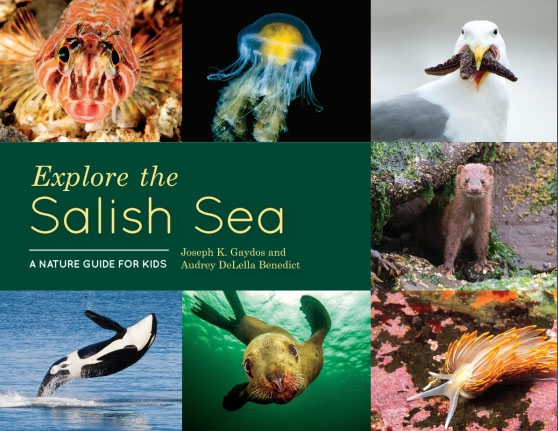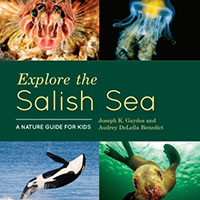— a review by Lin McNulty —

I am a Pacific Northwest native. My grandfather was born in Washington Territory. I am in my 27th year of living on Orcas Island, and I am fortunate to live in a waterfront home. Just in case that may sound like I know something about the Salish Sea and what happens under its waters and its shores, I am embarrassed to admit that’s pretty much the extent of my oceanographic knowledge.
When asked if I would like to review “Explore the Salish Sea: A Nature Guide for Kids” by Joseph K. Gaydos and Audrey DeLella Benedict, for Orcas Issues, I said of course I would, assuming it would be a quick read (it is a kids’ book, after all), but I was a bit mistaken. This is one of those kids’ books that should be read by adults, as well.
[perfectpullquote align=”right” bordertop=”false” cite=”” link=”” color=”” class=”” size=””]”You won’t find another place like the Salish Sea . . . anywhere.”[/perfectpullquote]
Right off, facts on the inside front cover caught my eye. Did you know that a harbor seal can hold its breath for almost 33 minutes, or that a killer whale’s teeth are 3 to 4 inches long? Huh, I didn’t.
Gaydos, of the SeaDocSociety, and Benedict, a biologist, writer, and naturalist, have created a lovely book that is more than primer. I want to say this book is delightful, yet that, too, is only part of the story. It’s chock full of glossy color photos that are both eye-catching and informative, and the chapters lead the reader through facts that would encourage and inspire the brain of any trivia buff. Not that this book is trivial; it certainly is not. It is a knowledgeable look at the creatures in our Sea, at the rocks on our beaches, at the plant life in and around our waters, and even takes us upstream to where salmon spawn; it’s a all a part of our Salish Sea.
“It is impossible for anyone to know everything about a place as diverse and marvelous as the Salish Sea,” they write. While that is certainly true, this book is an inspiring place to begin. Even for adults who want to load up on facts.
If you have a youngster who reads this book, be prepared to read it along with him/her. It may well stir up some invigorating conversations.
“We all depend on the Salish Sea. Doesn’t it make sense that we all should take care of it?”
**If you are reading theOrcasonian for free, thank your fellow islanders. If you would like to support theOrcasonian CLICK HERE to set your modestly-priced, voluntary subscription. Otherwise, no worries; we’re happy to share with you.**









Lin, I am so happy you did this review! I can hardly wait to get my copy. I must admit that even though I was born and raised in Seattle and have lived on Orcas for almost 36 years having boated up here from Seattle and up into BC for years before moving here it wasn’t until the past few years I had even heard the term Salish Sea! I don’t recall seeing it on any of our boating charts (though it could have been and I just don’t remember) either. We always followed those religiously when we were cruising. At any rate I’m anxious to learn about the Salish Sea, and this book (though a “kids book” sounds like just the right one. I do have some other books about the Salish Sea ordered, too, but this is the first one I want to delve into.
Again, thanks for the great review!
Ginny, the Salish Sea was re-named in 2009 so probably not on your navigation charts. This is such a fun book. See, I’m using my new knowledge already.
Thanks, Lin. I’m still surprised I don’t recall that re-naming taking place. My head must have been some place else at that time!
https://en.wikipedia.org/wiki/Salish_Sea
The first known use of the term Salish Sea was in 1988, when marine biologist Bert Webber from Bellingham, Washington, created the name for the combined waters in the region with the intention to complement the names Georgia Strait, Puget Sound, and Strait of Juan de Fuca, not replace them.[3] The adoption of the term, he said, would raise consciousness about taking care of the region’s waters and ecosystems. Webber’s efforts are credited with the official recognition of the term in Canada and the U.S.
Thank you, Lin. Your enthusiasm is catching. I’m looking forward to reading the book, and then passing it along for the sake of our precious and quite beautiful resources.